Save 20% Off SiteWide in our New Year Sale

Last month, I wrote a blog post about my 16-piece bushcraft toolkit for wilderness self-reliance, and it really caught the eye among my recent writings.
I've noticed a lot of interest from folks about self-reliance and surviving in the wild.
You know, there's something special about immersing yourself in nature and forming a deeper bond with the environment. It adds a whole new dimension to the adventure!
So, in this blog post, we will dive into the 10 essential skills you will need for wilderness survival.
We'll cover everything from getting prepared to staying positive, because let's face it, survival can be quite the journey.
Furthermore, in today's world, knowing how to survive in the wild is becoming more and more valuable. These skills will just come in handy when you least expect it.
Are you ready? Let's embark on this adventure!
Get ready and plan in advance
If you've been following my blog, you probably know I'm all about preparation, whether it's planning a hike, a camping trip, or a bushcraft adventure.
First things first, before you venture into the wilderness, it's essential to do your homework.
Check out the environment and keep an eye on the weather forecast, especially here in Hong Kong where the weather can change fast. Staying updated before and during your trip is key.
Make sure you know where to find water and learn about edible plants, berries, and animals for food.
Understanding the terrain, wildlife, and any potential dangers will help you make smart decisions and be ready for whatever comes your way.
For example, if you encounter a snake on the trail, don't panic and stay calm.
Next, create a detailed plan for your adventure. Map out your route, estimate how long it'll take, and highlight any places of interest.
Share this plan with a trusted friend, family member, or park ranger. If something goes wrong or you don't check in as expected, they'll have crucial information to help with search and rescue efforts. Safety always comes first!
Lastly, don't forget to pack the right gear. Having the proper equipment can make a huge difference in the wild.
If you haven't put together your own toolkit yet, you can check out our essential 16-piece bushcraft toolkit for ideas on what to include or adjust based on your own requirements.
Just make sure you've got top-notch gear, and take the time to learn how to use it properly.
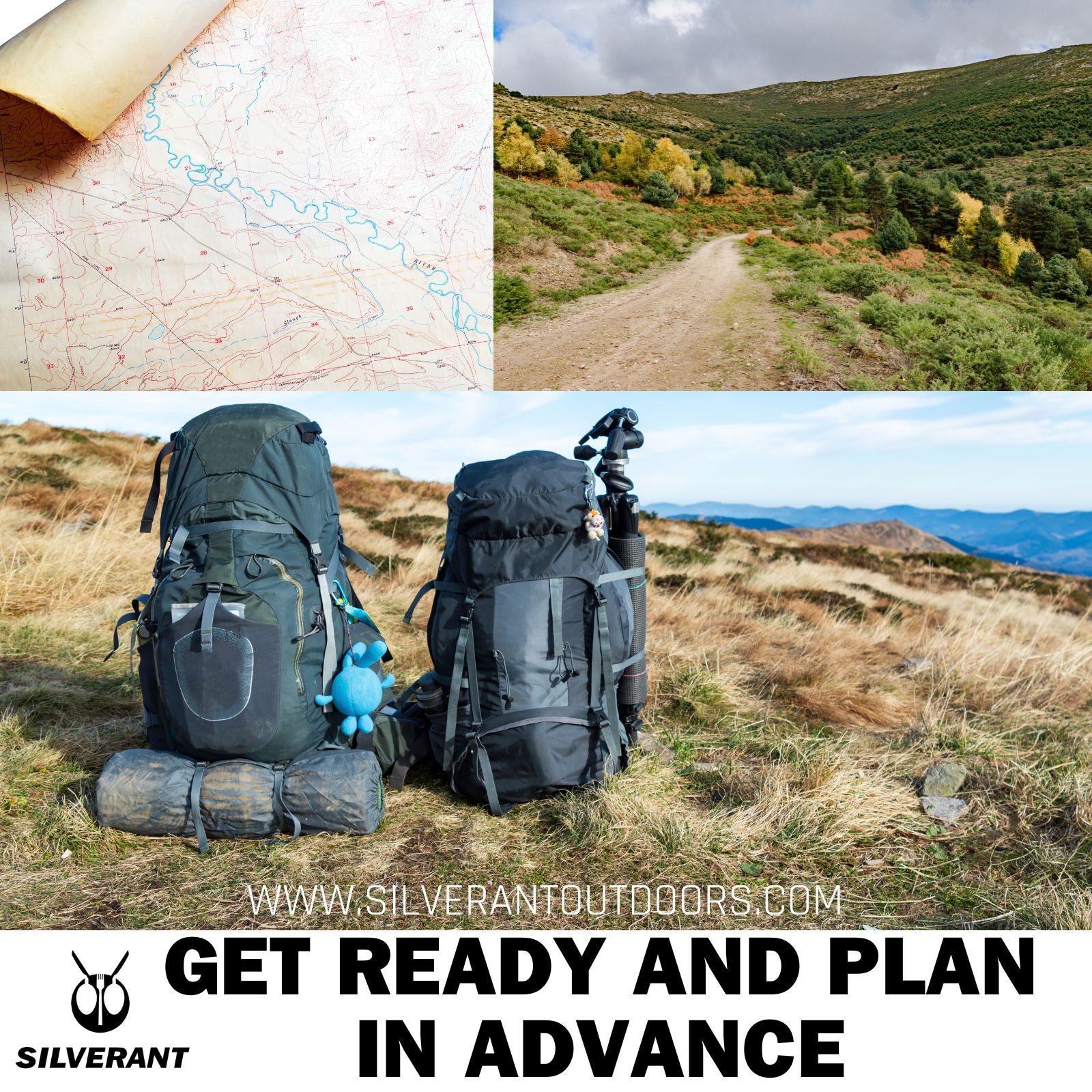
Navigate the wild
Once you're all set, it's time to head out on your adventure.
And the second skill you need to nail down is navigating to your destination safely.
First off, in today's tech-savvy world, having a GPS device is like having a trusty sidekick, and getting the hang of it isn't too tricky.
It helps you find your way, tracks your progress, and can be a real lifesaver in unfamiliar territory.
Plus, with two-way messaging, you can keep your loved ones updated and share your adventure with them.
Just remember to pack spare batteries for your GPS.
But when you're faced with tougher survival situations where GPS isn't an option, mastering the art of using a topo map and compass becomes essential.
Mastering them is not a breeze, so it's essential to learn and take courses.
To get a basic grasp of the skill, be sure to check out our Navigating the Wilderness Tips first.

Construct a shelter
When you arrive at your destination, the first thing on the agenda is to put together a sturdy shelter.
In the wild, there's no prepped campsite waiting for you. You've got to make do with what nature provides and the tools you've got on hand.
At the start, a tent can do the trick. But as you get more experienced, it's important to learn how to construct your own shelter using natural materials.
Not only is it a more rewarding experience, but it also adds an extra layer of safety when a tent isn't an option.
First things first, just like I've mentioned in my previous blog posts, location is key.
Look for spots with natural protection, like the sheltered side of hills or cliffs.
But steer clear of low-lying areas prone to flooding, and watch out for hazards like dead trees or loose rocks. Safety is always in the first place!
As for building your shelter, you've got a few options. You can go for debris huts, lean-tos, or snow caves, using branches, leaves, moss, snow, and whatever else nature offers.
Since we don't get much snow in Hong Kong, I usually go for lean-tos. They're easy to set up with tarps and ropes, which come in handy when the weather unexpectedly changes.
But if you're not sure about these survival shelters, check out the blog piece: "Survival Shelters: Building Effective Protection in Challenging Environments."
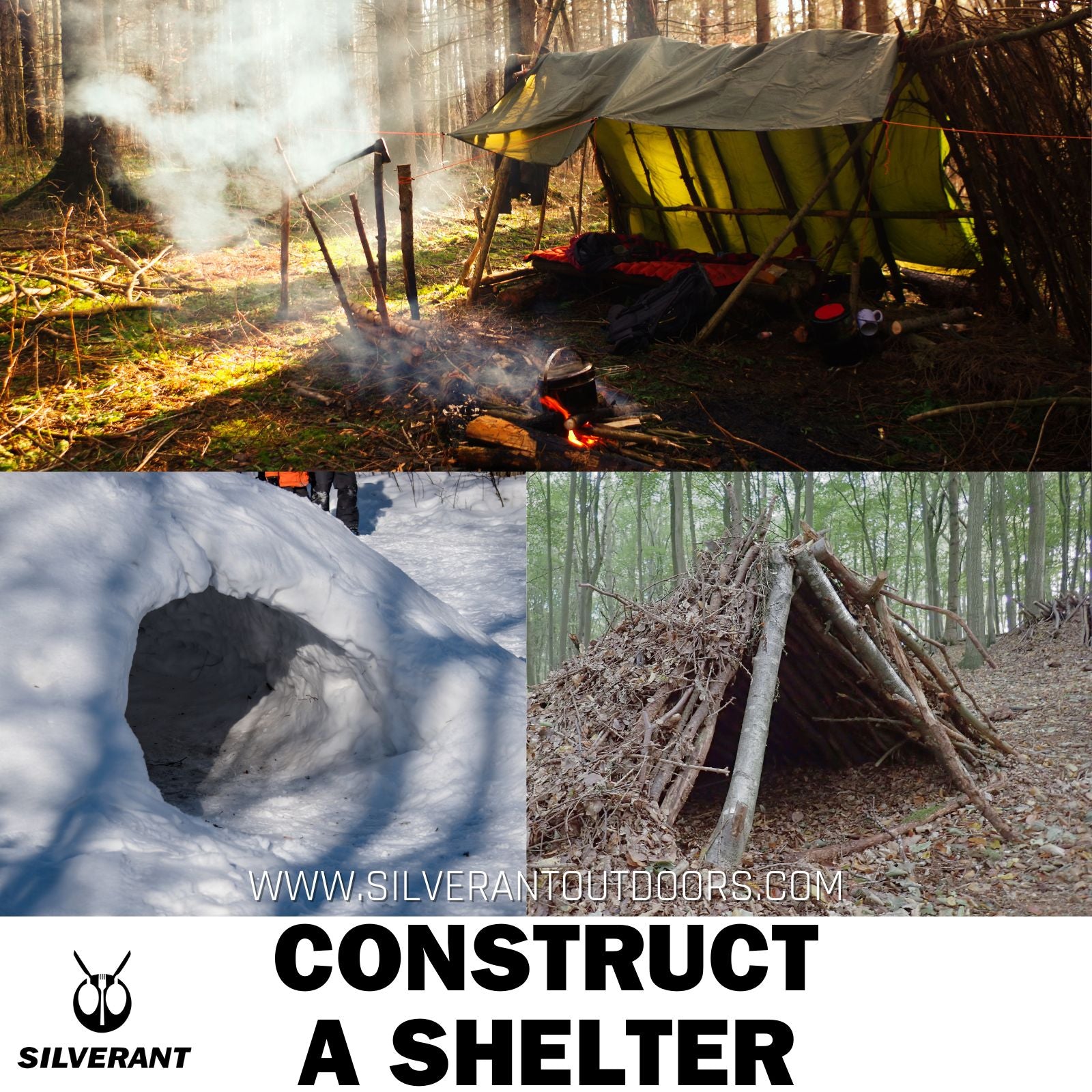
Build a Fire
With your shelter sorted, it's time to focus on feeding yourself.
But before you can boil water or cook food, you've got to get that fire going.
When it comes to building a fire, safety is paramount as well, just like when you were setting up your shelter.
That means avoiding dry grass, leaves, or branches that can catch fire easily.
Digging a fire pit or using rocks to contain the flames is the way to go.
And make sure you pick a spot that's sheltered from the wind. Wind can cause fires to spread rapidly, making them difficult to control.
Next up, let's gather your firewood. You'll need three kinds: Tinder, Kindling, and Fuelwood.
Tinder is small and dry stuff that catches fire easily, like dry leaves or grass.
If you can't find any tinder, you can use your knife to cut some from the kindling.
Kindling is a bit bigger and helps the fire keep going, like twigs or small branches.
And Fuelwood is the big stuff that burns for a while, like logs or thick branches.
But here's the trick: always collect more firewood than you think you'll need. It's better to have too much than too little.
To start your fire, using a flint rod and steel striker is a solid bet. They're reliable and don't run out like matches or lighters.
But if you're really in a pinch and don't have access to a flint, a bow drill can do the trick.
I'm not a big fan of the hand drill method because it takes a ton of energy, even with gloves on.
Lastly, to build your fire, start by making a little nest with your tinder in the center of your fire pit and arrange your kindling around it in a teepee shape.
Make sure there's some space between the sticks for air to get in and feed the flames.
Then light your tinder. Get a flame going on a few spots of tinder and blow gently to help it spread. Once the tinder's burning, the kindling will catch fire too.
As your kindling starts burning, add bigger pieces of fuelwood to the mix.
Just be careful not to smother the flames—arrange the logs around the outside of the kindling.
Once your fire's going strong, keep an eye on it and make sure it stays under control.
Feed it from the bottom up with more fuelwood, and don't add too much at once or you'll smother it.
Starting a fire is one of the most important skills in any survival situation. In fact, it's what really made us human way back in the day.
And if you want to learn more, don't forget to take a look at the article: "Firecraft Fundamentals: Starting Fires in Challenging Conditions."
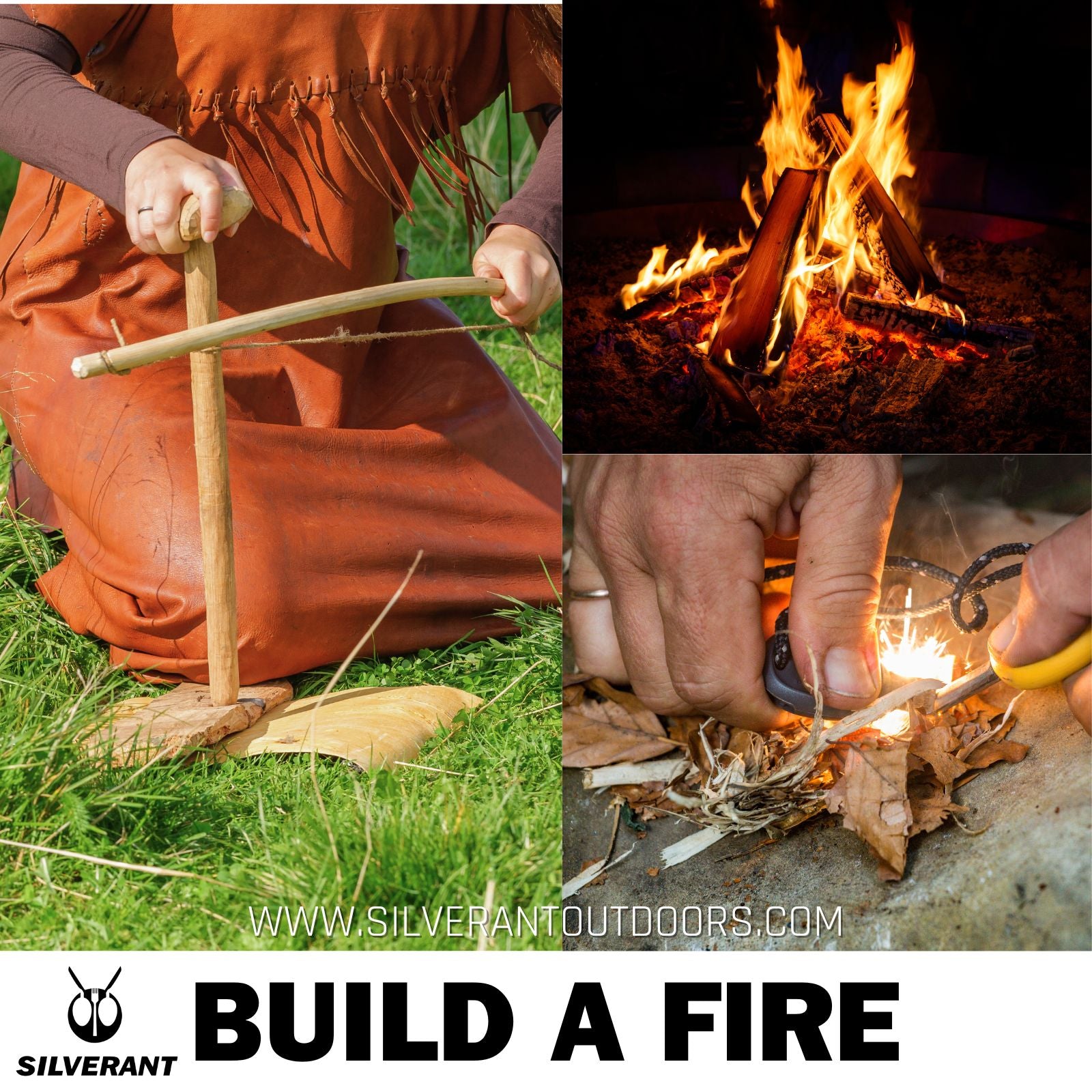
Find and clean water
And once you've got a fire going, getting safe drinking water is a breeze.
But first things first, you gotta find water sources out there.
You can look for signs like plants, animal tracks, or sunken ground that probably mean there's water below.
Listen for the sound of flowing water—it could lead you to a stream or river nearby.
And if you're around mountains, melting snow or ice can do the trick.
Keep your eyes and ears open, and make finding water your top priority.
But remember, you can't just drink it straight from the source. You gotta purify it first.
In survival situations, getting your hands on fancy filters can be tough. So boiling the water and adding a purification tablet is the way to go.
All you need is a sturdy titanium water bottle. Just boil the water in it, let it cool down, and you've got yourself some safe water to drink. Easy as pie.

Identify and gather wild food
Once you've got water sorted, it's time to think about food.
As we mentioned earlier, a balanced meal of carbohydrates, fats, and proteins is what we're after.
For carbs, edible plants and berries are your go-to. But be careful—make sure you know which ones are safe to eat and which ones to steer clear of.
Here are some tips:
Don't Follow the Animals: Just because deer munch on something doesn't mean it's safe for us. Stick to what you know is safe.
Use Your Senses: In non-survival situations, it's best to avoid unfamiliar plants. But in survival mode, give them a sniff first. If it smells funky, don't eat it. Crush it up and smell again to be sure. Then, touch it to your lips and tongue before taking a small bite. Watch out for any tingling, bitterness, or swelling.
Watch Out for Lookalikes: Some plants try to trick us with their doppelgangers. Make sure you're eating the real deal.
Test Before You Feast: Gather a bit of whatever you find, but only take a tiny taste at first. Wait an hour to see if there's any reaction before chowing down. And if you're still unsure, better to play it safe.
And as we mentioned earlier, make sure to learn about edible plants from guidebooks, online resources, and local experts before you go on your trip.
For fats and proteins, animals are your best bet. Learning basic trapping and fishing techniques will increase your chances of catching some grub.
Study different traps like deadfalls and snares. Also, get the hang of fishing using a line, hook, and natural bait, or try spearing fish with a sturdy sharpened stick.
But be sure to practice these skills in a safe setting before putting them to the test in the wild.
Once you've got your catch, cook it up in your trusty cookware for a hearty meal.
But if you're up for trying different cooking methods beyond pots and pans, you can explore grilling on a stick, steam pit cooking, and other techniques.
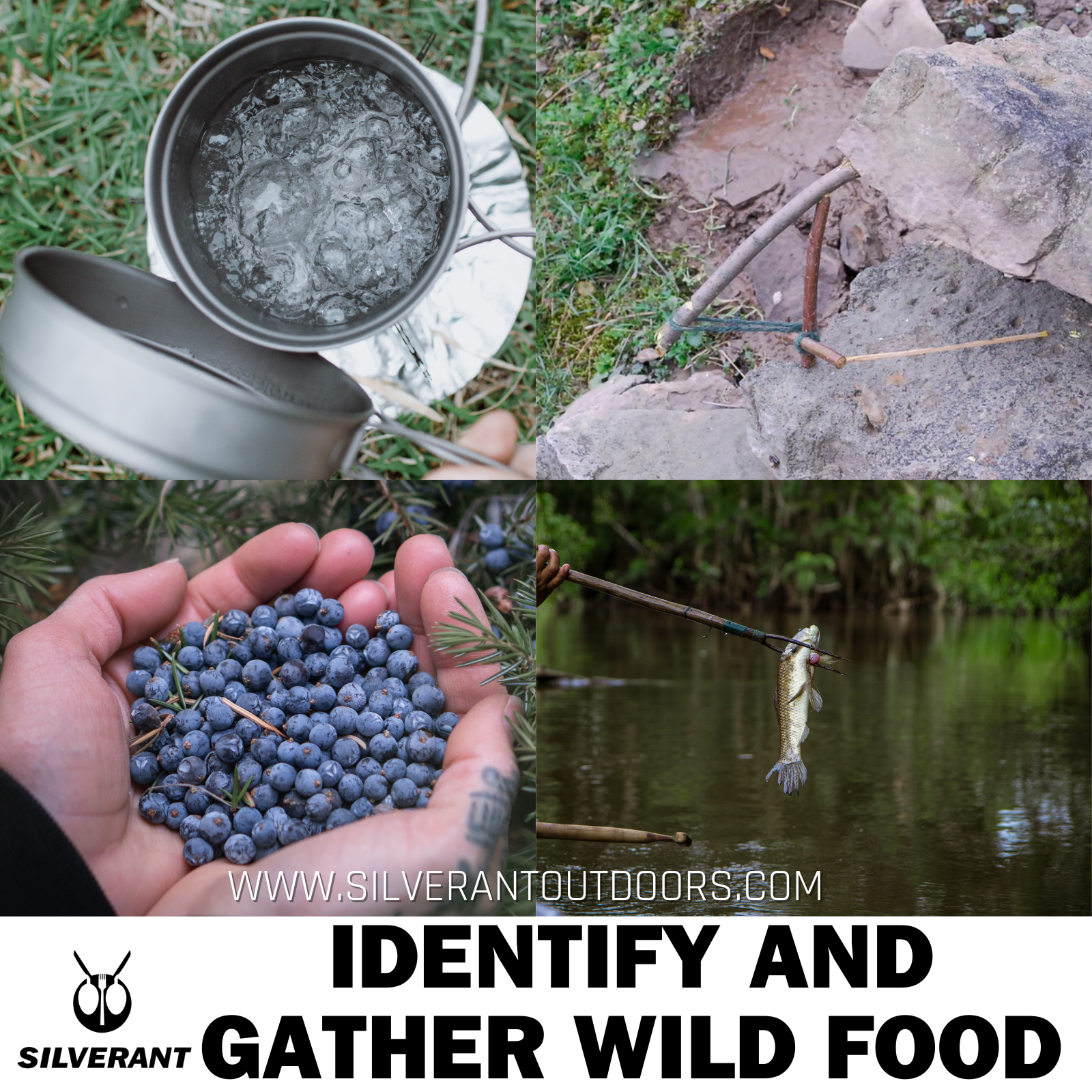
Master knife and tool use
But to ace those skills we just covered, you've gotta nail down how to use tools like the knife, cord, and handsaw first.
They pretty much cover all aspects of your survival.
Let's start with the knife. In shelter construction, it's indispensable for shaping branches, cutting foliage for insulation, and fashioning stakes to secure your shelter.
When it's time to kindle a fire, the knife proves invaluable for prepping firewood, shaving tinder, and fashioning feather sticks to catch sparks. It's also a reliable aid for slicing firewood into manageable pieces.
And when mealtime rolls around, the knife is your trusty companion for crafting trapping and fishing tools, cleaning games, slicing fruits and veggies, or preparing various food items.
In first aid situations, its versatility shines through, as it can cut bandages, remove splinters, or even handle minor surgical tasks in dire circumstances.
Plus, in emergencies, it doubles as a tool for self-defense against wildlife or other threats.
However, when picking a knife, go for one made of stainless steel, Damascus steel, or carbon steel, with a full tang for extra durability.
Moving on to cordage. You can use it to tie together branches for shelters, secure tarpaulins for shelter roofs, or create chairs, tables, or even bridges.
It's also handy for making fishing lines, setting up traps and snares, crafting makeshift splints or slings in first aid situations, repairing gear or clothing, marking trails for navigation, and hanging food to keep it safe from animals or suspending cooking pots over a fire.
Lastly, the handsaw. Similar to a knife, it's super versatile as well. You can use it to cut branches and logs for shelters and bedding, chop firewood for warmth and cooking, process game for eating, shape wood into tools, and even clear paths through thick vegetation.
In a nutshell, mastering these three tools is a total game-changer in survival situations.
Make sure you're familiar with them before you head out into the wild.
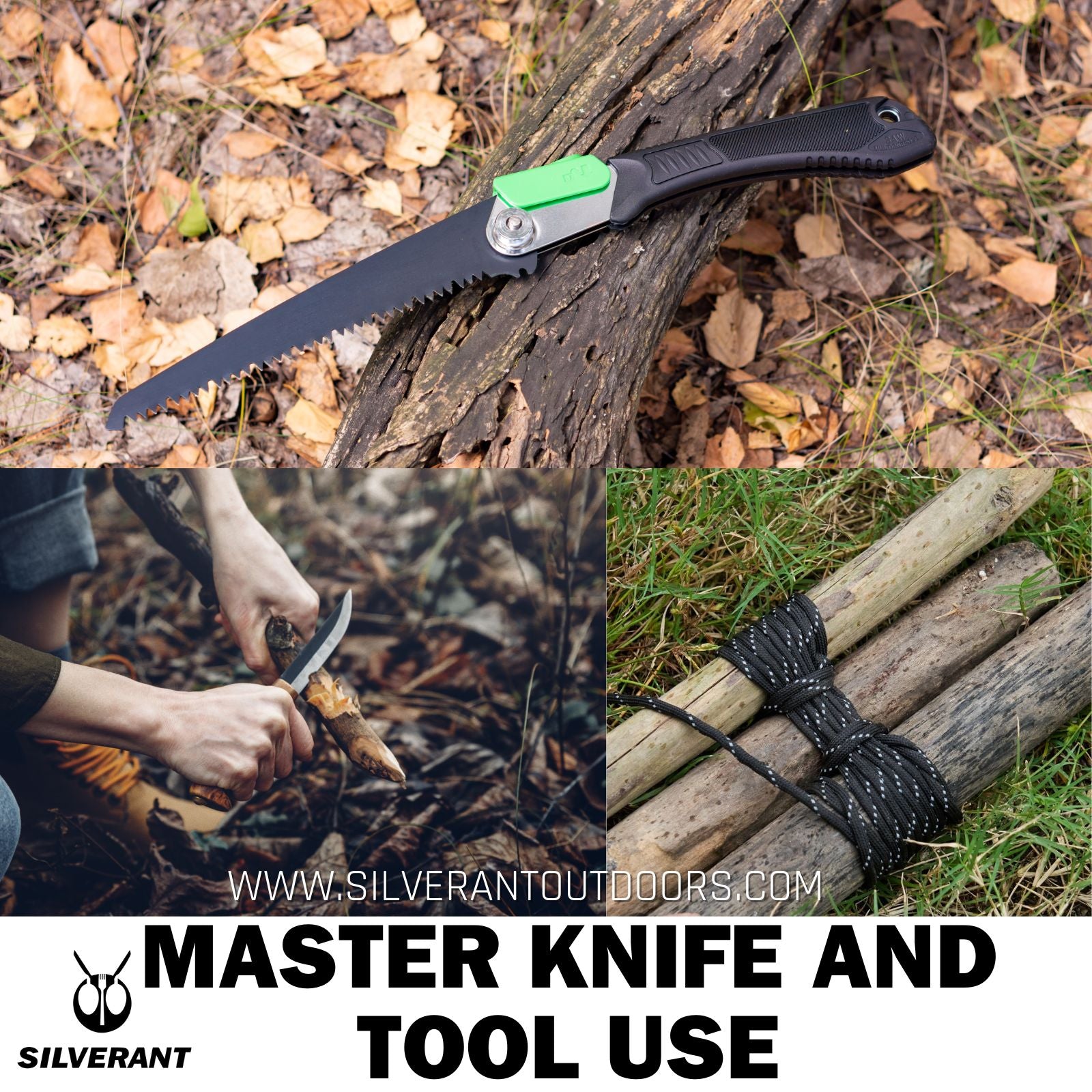
Know basic first aid
And when you're using your knife and tools, it's really important to be careful to avoid any accidents.
Wearing work gloves can help lower the risk, but it's still possible.
Plus, when you're out exploring, injuries can also happen out of the blue. That's where first aid skills come in handy.
First things first, you've got to pack a good first aid kit.
Make sure your kit includes basics like adhesive bandages, sterile gauze pads, adhesive tape, antiseptic wipes, tweezers, scissors, and pain-relieving medication.
Customize it to suit your needs, and remember to regularly check and restock the supplies to keep them prepared for any situation.
Next, it's equally crucial to know essential first aid techniques to deal with common injuries in the wilderness.
This includes treating cuts, burns, sprains, insect bites, and allergic reactions.
Learn how to properly clean and dress wounds, immobilize injuries, and administer basic CPR if necessary.
Taking a basic first aid course or wilderness first aid training can give you valuable skills and confidence in handling emergencies.
Before attending a course or training, you can read up on Wilderness First Aid Crucial Tips to gain a basic understanding.

Signal for rescue
But when things take a turn for the worse, and you're unable to continue even after first aid, facing severe situations, or getting lost, it's crucial to signal for help.
First off, make sure you're familiar with distress signals that can grab attention and let others know you need help.
These could include shouting or yelling at regular intervals, blowing a whistle in bursts of three, waving bright-colored clothing or reflective objects, creating smoke from a fire during the day, or using a flashlight at night.
Knowing when to reach out to search and rescue (SAR) teams is just as important in critical situations.
Provide them with accurate details about your location, situation, and any injuries or medical conditions you have.
Follow their guidance and instructions to help them carry out a successful rescue operation.
Remember, signaling for help is a vital step in getting the assistance you need during a wilderness emergency.
Stay calm, make yourself visible, and use the available resources and signaling techniques to improve your chances of being found quickly.

Stay calm and positive
Lastly, it's crucial to stay calm and positive.
In survival situations, having a strong mindset is key more than ever.
But don't worry if you're not there yet. Here are 12 tips to help you build up your mental resilience.
I didn't have it at the start either, but with practice, I'm improving every day.

Conclusion
Congratulations! You've made it through the 10 essential outdoor survival tips that every adventurer should know.
To sum up, remember to prepare and plan ahead for a safe adventure, use navigation skills to reach your destination safely, and build a shelter to protect yourself from the elements and potential dangers.
Then, use tools to make a fire not only for warmth but also for safe drinking water and a hearty meal to keep you energized.
Next, know how to use basic first aid when injured and signal for help if things get worse.
And always stay calm and positive, no matter what challenges the adventure throws at you.
Now, armed with this knowledge, you can venture forth with confidence, embrace the wild, and let the spirit of adventure guide you on unforgettable journeys.
But remember, these tips are just the beginning of your survival journey. It's crucial to practice and refine these skills regularly.
Stay curious, keep learning, and look for chances to boost your outdoor survival know-how.
How many skills have you mastered? What challenges have you faced while learning them? Feel free to drop us a comment and share your experiences.
To your next adventure
Steve












































